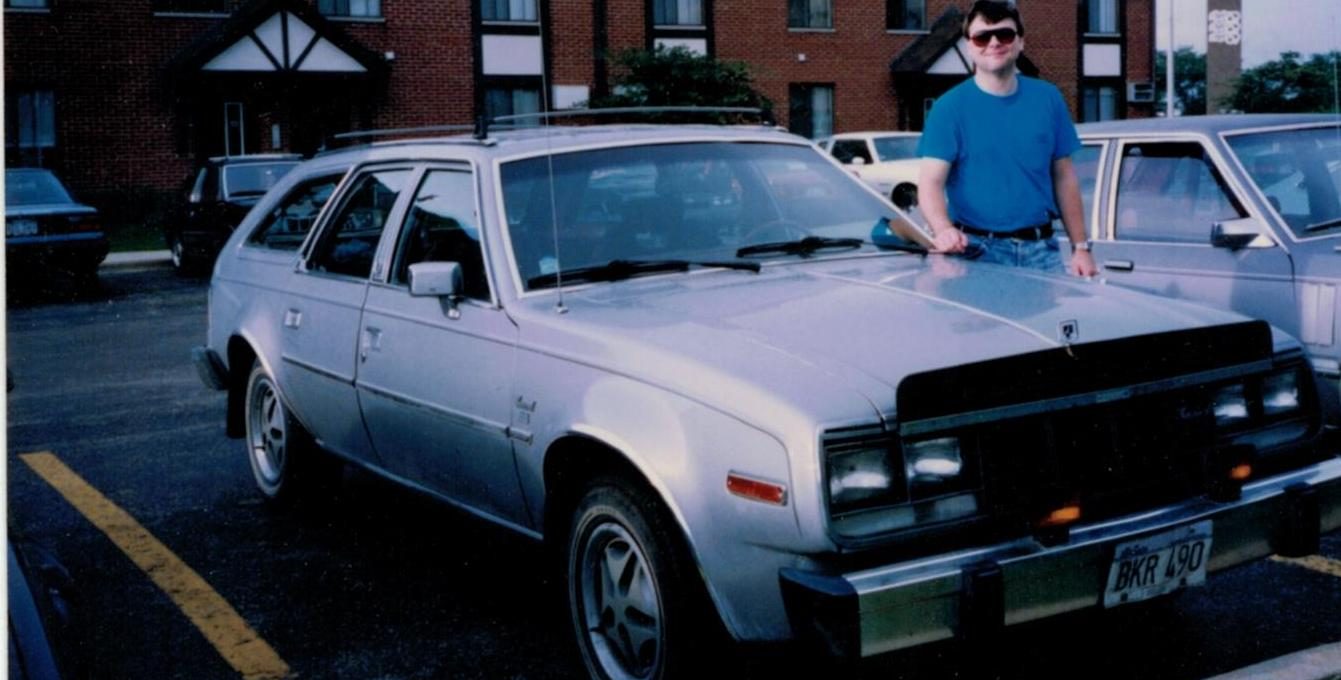This is a bit of a follow-on to my earlier post about woodies. The only reason it is happening is I was looking for the photo I had of Jack Goeken giving a speech to us at Airfone. I saw it a few months ago and said to myself “You really need to put this some place safe so you can use it in the story.” You can all guess what happened then. I have found all of the photos which were with it, just not the one I put someplace safe.
I was rather stunned to find I still had a few pictures of the old Concord. Is there any car more deserving of some great ode than the car which helped you work your way through college? I guess if you didn’t have to work your way through college you wouldn’t know, but, the rest of us understand.
Were I to think long I would probably have a book’s worth of stories involving that car. Since I found other photos we will talk about the trip to Denver, Colorado I took with my friend Kurt. We were both in Junior College at the time and a friend I called One o’clock had moved out to Denver and would soon be marrying her boyfriend. We were on winter break and it seemed like a good idea. Adding to that she had a ton of stuff at her mom’s place she wanted me to haul out. Her mom had been shipping things, but glass aquariums really don’t ship well. This car is a station wagon after all, but when I picked Kurt up we barely had room for his luggage. The skis could go on top, but we had to repack the back to get everything in, then we set out to Denver via I-70.
Every story you write has multiple critical yet less interesting stories surrounding it. This story is no exception. Unleaded gas had recently been forced on Americans. Most farms get fuel truck delivered to bulk storage tanks, but the truck prices were way higher than station prices. Lots of farmers still had gas 2-ton trucks to haul grain. We might have still had our gas combine. I know we still had 2 gas tractors. Since dad hauled grain on the side we went through a lot of gas. Lots of farmers did. The ag world had not yet completely switched to diesel. As a result of all these things farmers were picking up 100-300 gallon portable fuel tanks. By “portable” I mean they would fit cross way in the back of a pickup truck. They just had to be completely empty and you needed 4 people to hump them up there. They were all steel back then. (The previous sentence is really important so read it twice and remember it.)
Farmers were making multiple trips per day to which ever gas station had the cheapest gas price per the coffee shop or the CB radio. We didn’t have GasBuddy.com then. They would fill up that tank then hand pump it off into their bulk storage tanks. Why? It’s nothing to go through 2,000+ gallon of fuel during either planting or harvest. You needed to get it as cheap as possible. The price for rural delivery kept going up and the price at the pump stayed low. This “always use the cheaper gas” mentality spilled over into what we put in our cars. If the pump price was below the cost of what was in the bulk tank we would fill up in town. Otherwise we filled up at home. Of course, the last one wouldn’t fit in the bulk storage tank so you hand pumped it into the vehicle which needed fuel. Yes, hand pump. We didn’t have those fancy battery operated electric pumps. At first they didn’t exist and then you couldn’t afford them.
With enough snuff to make the journey and lots of soda we set off for Denver. Being 2 college kids we decided to drive straight through taking turns. The passenger seat did recline “some” and it was comfy enough to sleep in so not a big deal. After driving through a blinding snow storm which had I-70 down to one lane through part of Kansas, we started having this problem, cruising along at highway speed or better it would suddenly buck a few times and the engine would quit. The first two times we pulled over then after finding nothing wrong we would try starting and it would take off like nothing ever happened. When it first happened it was an oddity. Then it would happen about every half a tank so we thought we bought more water than gas at a station. Heet and other additives didn’t help the problem kept getting worse. It started happening once per hour or so.
Keep in mind this was a “new” car. It had only 8.000 miles on it and I hadn’t had it a year. There was still “some” factory warranty but AMC was going belly up so . . . Needless to say we got really good at tossing the car into neutral and coasting for a bit then hitting the ignition and dropping it back in drive. We got to Denver this way. It was around the holiday so shops were either too busy or wanted waaaaay too much money to look at it. Had we been back home we wouldn’t have even though about taking it to a shop. In the end, once our stay was over and we had filled out job applications at MCI and a few other places, we started home. The problem didn’t get worse, just got more random. We had spent the bulk of our money and were riding back mostly on a gas credit card. When I got back home I found it to be an expensive fix if I let the dealer do it. The part was only $1.50 but you had to drain the fuel tank and they charged labor for the amount of time it took for the tank to drain.
Remember I told you those tanks used to be steel? Remember I told you that sometimes we would hand pump straight from the transportation tank into the vehicle? Well, here’s what happens with steel transport tanks. They sit for months out of the year empty and unused. The inside of the tank rusts. Not rusts through, just rusts. When you put fresh gasoline in it the additives for cleaning your engine start scrubbing off flakes of rust. Back in that day every car had what was called a sock filter in the tank. It is at the end of the fuel pickup line and is there to stop big chunks of rust from getting to the fuel pump. Other filters along the way take out ever smaller pieces of stuff. Eventually you get enough rust in your tank it clogs the sock filter.
Very few vehicles of the day made it easy to replace that filter. By the 1990s they had solved this problem. My 1990 Jeep Grand Wagoneer had an access panel under the carpet in the back. A few screws and you could disconnect the wires, fuel lines and unscrew the big plastic nut to pull the fuel pump and put in your new sock filter.
Today you don’t hear about this. It does appear many vehicles still have them and they cause some heated discussions. In fact, fuel filters don’t have recommended replacement intervals on many vehicles. The interval is “when something bad starts happening” which was pretty much how we replaced them before, but, bad things happened more often.
How did we get here? Underground fuel storage tanks are pretty much all plastic/fiberglass/non-metal synthetic substance which won’t rust. In-ground fuel tanks used to be made of steel which eventually rusted through and leaked gas into the groundwater. Bitch all you want about the EPA, but, they are the reason we don’t have a blend of unleaded and water being pumped out our faucets. Pretty much every pump at every island in every gas station now has a fuel filter on it. That wasn’t the case in earlier decades. Unleaded gas is made a lot cleaner now and alcohol most of it contains keeps the delivery systems clean. Most importantly, your actual gas tank is some kind of plastic now. There is a protective metal shell around it, but the old steel tank which rusted on the inside when it wasn’t kept clear full is a thing of the past.
You still need a sock filter “just in case” but, that’s really the only reason you need it now so you will probably never replace one.



One thought on “My 1980 AMC Concord”